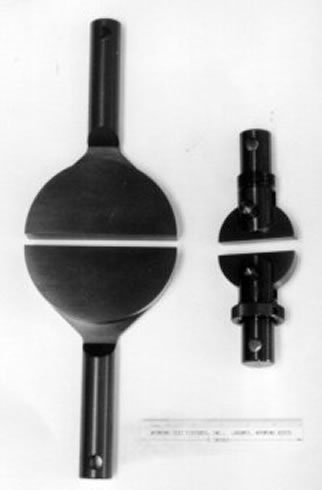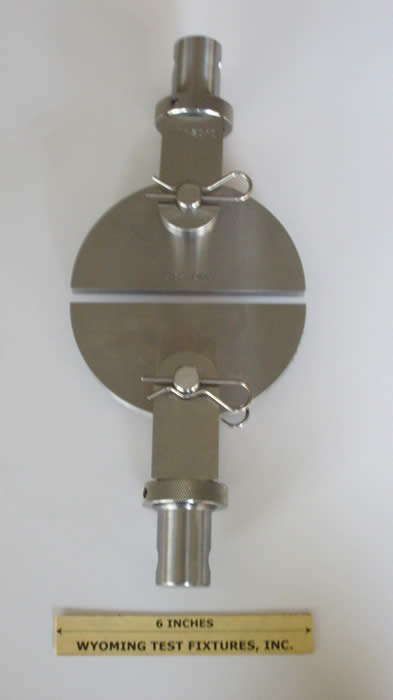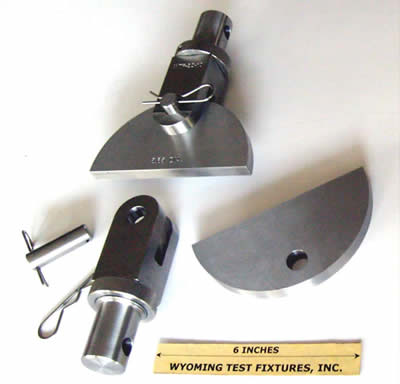Split-Disk Tensile Test Fixture (ASTM D2290)
Model No. WTF-SD (Stainless Steel)

Fig. 1: Original Type A fixture (now discontinued) on left and current Type A, B, and C fixture on right.
ASTM Standard D 2290 (Reference 1) originally included three procedures for testing ring specimens. The original Procedure B and C specimens, extruded and molded unreinforced plastic specimens and larger diameter extruded plastic pipe, respectively, utilized fixtures of the general type shown at the right side of Fig. 1.
The original fixture for testing Procedure A specimens, i.e., parallel-fiber-reinforced ring specimens, shown at the left side of Fig. 1, was deleted from the standard in 2000, after responsibility for maintaining the standard was transferred from Committee D-30 Composites to Committee F-17 Plastic Piping.
However, this now deleted original Procedure A fixture, while no longer an ASTM standard, is still used for testing filament-wound composite rings, and the fixture is available from Wyoming Test Fixtures, Inc.
Although this original Procedure A test method was an ASTM standard from 1964 to 2000, its popularity has varied over the years. One criticism is that some bending is induced in the ring specimen at the split. This is even reflected in the title of the standard, “Apparent Hoop Tensile Strength …”. This potential error is analyzed and discussed in detail in References 2 and 3. Friction between the split disk fixture and the ring specimen is also a concern. These effects are discussed in References 3 and 4. In general, this test method is still generally considered an acceptable test for unidirectional (hoop-wound) composite rings.
These former Procedure A specimens are hoop-wound rings of controlled diameter, width, and thickness, viz., 5.750" inside diameter, 0.250" wide, and 0.060" thick, to fit the standard test fixture.
The revised ASTM D2290 standard still designates Procedures A, B, and C. Procedure A is now used for testing reinforced-thermosetting resin pipe, Procedure B for thermoplastic pipe of any size, and Procedure C for thermoplastic pipe with nominal diameters of 4.5” and greater.
All of these revised procedures use the same general fixture configuration (the configuration shown on the right side of Fig. 1, and in Fig. 2 below), the fixture size varying to accommodate the particular specimen size of interest. Within limits, specimens of varying sizes can be tested using the same holders, by using interchangeable pairs of split disks.

Fig. 2: Current test fixture configuration used in ASTM D2290.

Fig. 3: Partially disassembled Split-Disk Tensile Test Fixture.
These various specimen configurations and test procedures are fully defined in the 2012 version of ASTM D2290 (Reference 1). Details of the now obsolete fixture and specimen for testing filament-wound rings can be found can be found in 1992 and earlier versions of ASTM D2290.
The 2012 version of ASTM D2290 has added a Procedure D, for testing polyethylene pipe with a nominal diameter of 14" and greater and preferably having a wall thickness 1" and greater. Rather than testing a complete ring, two 4" long segments of the ring are tested together in a special fixture fully defined in ASTM D2290-12.
Source of Additional Information:
1) ASTM Standard D 2290-12, "Apparent Tensile Strength of Ring or Tubular Plastics and Reinforced Plastics by Split Disk Method," American Society for Testing and Materials, West Conshohocken, Pennsylvania (first issued in 1964).
2) C.E. Knight, Jr., "Failure Analysis of the Split-D Test Method," Composite Materials: Testing and Design (4th Conference), ASTM STP 617, American Society for Testing and Materials, West Conshohocken, Pennsylvania, 1977, pp. 201-214.
3) S.H. Yoon, W.M. Cho, and C.G. Kim, “Measurement of Modulus in Filament Wound Ring Specimen Using Split Disk Test,” Experimental Mechanics, January/February 1997, pp. 25-28.
4) I.A. Jones, V. Middleton, and M.J. Owen, “Roller-Assisted Variant of the Split Disc Test for Filament-Wound Composites,” Composites, Part A, Vol. 27A, 1996, pp. 287-294.

